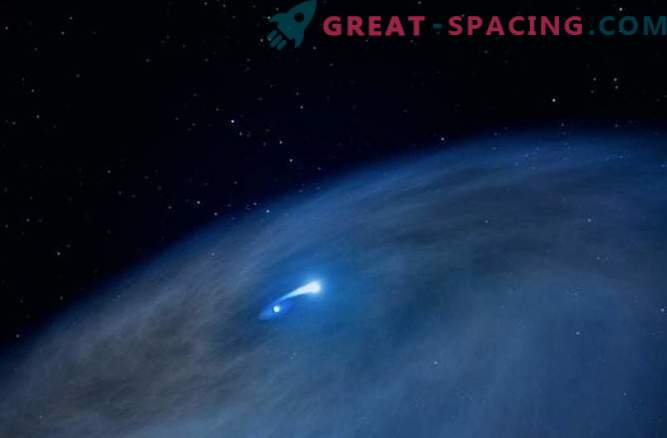
According to the latest data, the cause of a strange phenomenon associated with an extra-large star called “Nasty 1” (lit. “Unpleasant 1”) may be the rarest act of star cannibalism.
The Hubble telescope discovered around Nasty 1 - a huge, gas-based, 4, 8 trillion km long disk, which could have been created by a Wolf-Rayet star.
The Wolf-Rayet stars are huge bodies that, some time after formation, surpass the sun in weight by two dozen times, but over time the layer of hydrogen, which makes up most of the star, disappears, leaving one star from the star. Scientists still do not know exactly why this is happening, but there are several theories.
Some believe that the cause of the disappearance of the upper layers of stellar gas is a strong stellar wind, which literally blows off hydrogen into open space. Others are of the opinion that the star is being absorbed by the companion star.
“We believe that this is exactly what is happening with Nasty 1 now,” said John Mauren, a scientist at the University of California. “The Wolf-Rayet star hides in the depths of this disk, and the nebula itself was created in the process of mass exchange. Because of such a sloppy process of absorbing one star, another name, Nasty 1, seems to be most welcome. ” A nebula of this kind around the Wolf-Rayet star is observed for the first time. According to scientists, only a few thousand years have passed since its inception, and it is at a distance of three thousand light years from Earth.
A few more facts in support of the theory of stellar cannibalism: the majority of super-large stars exist in binary systems (have a companion); according to calculations, the stellar wind does not have enough power to blow off most of the star’s mass.
“We concluded that all Wolf-Rayt stars cannot be viewed from the point of view of the traditional stellar wind system, because in this case body loss of mass per unit of time is much less than expected,” said Nathan Smith, a researcher at the University of Arizona. - The exchange of masses between the stars of binary systems looks more reliable and explains the processes occurring with the giant luminaries in them. Finding a star in such a short developmental phase will help us understand the way in which supernovae are formed. ”
Exact calculations of the mass and size of the star Nasty 1 (the name comes from the formal designation NaSt 1 - from the names of the discoverers) have yet to be obtained. Due to the thick cloud of gas, it is impossible to say for sure either the parameters of the star itself, its mysterious companion, or the distance between them. Also unclear is the future of the luminary. But whatever happens to a star, its evolution “certainly won't be boring,” as Mauren put it.
According to him: “Wolf Rayt may explode into a supernova or connect with a neighbor. The future of the system is full of rare events and unforgettable sights, it all depends only on the masses of the luminaries and on how long they can remain in the shadow of the gas cloud. ”
The study of the phenomenon associated with Nasty 1, published online on May 21 at the Royal Astronomical Community website.











































